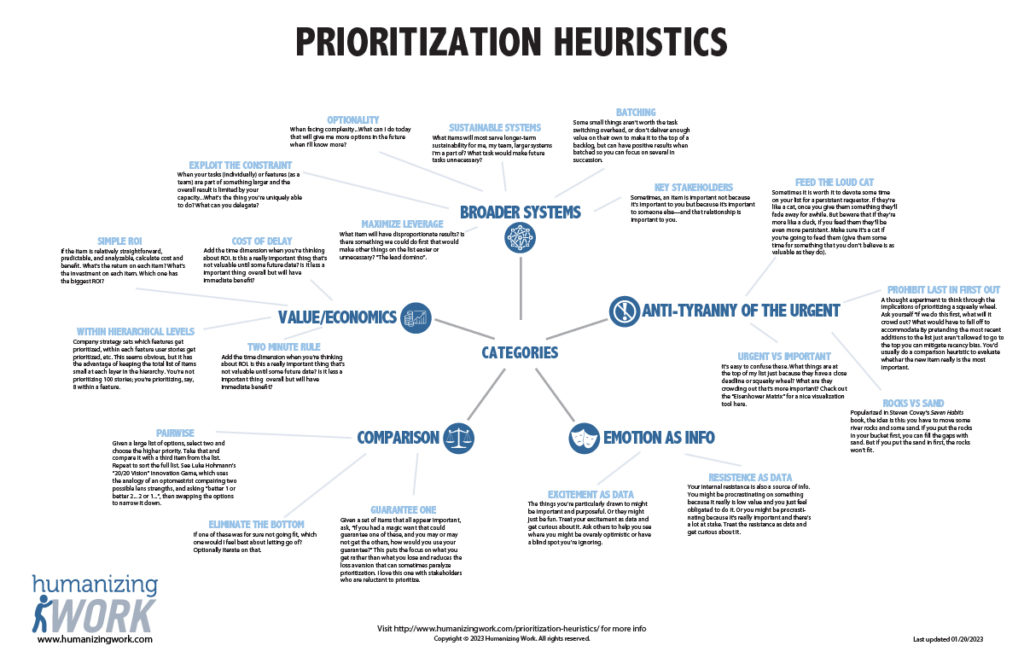When we survey Product Owners on the techniques they (actually, not officially) use to prioritize backlogs, we consistently get three answers:
- HiPPO (Highest Paid Person’s Opinion)
- Squeaky Wheel
- Gut Feel
We expected to hear more analytical answers—named approaches, spreadsheets, processes. Many of the people we talked to are fantastic product people, they have strong track records of delivering great products with strong business outcomes. If most of them are using a gut feel approach, we wondered if there were patterns that were intuitive to them that we could make more visible. We interviewed several of them, we looked at our own approaches to prioritize our work, and we synthesized a lot of advice and literature to boil it all down to 18 heuristics in five categories.
It turned out that naming these patterns had two big benefits beyond just describing what people do. First, it allows the person prioritizing to better understand, reason about, and tune their intuition. Second, a clearer understanding of why your intuition suggests a decision allows you to bring others along, get their input, and discover where you might have some blind spots.
The heuristics are also really helpful for personal prioritization-the same rules apply to figuring out what to focus on today and what to say no to.
1. Comparison
Guarantee one – If I could guarantee one of these got accomplished (somehow) [today, this week, etc.], which one would I use my guarantee on? Optionally iterate on that.
Choose the bottom (to eliminate) – If one of these was for sure not going fit, which one would I feel best about letting go of? Optionally iterate on that.
Pairwise (20/20 vision) – “Number 1 or number 2. 1? Ok, number 1 or number 3.” Just like the optometrist.
2. Value/Economics
Hierarchical prioritization – Prioritize your projects, do your next actions for each project in the priority order of the projects. (Or whatever hierarchy makes sense.)
Simple ROI – What’s the return on each item? What’s the investment on each item. Which one has the biggest ROI?
Cost of Delay – How does the ROI change over time? E.g., the really important thing that’s not valuable until some future date vs the less important thing with immediate benefit.
2-Minute Rule – Will it be faster to just do it than to capture the task on my todo list? Just do it.
3. Anti-Tyranny of the Urgent
Urgent vs Important – It’s easy to confuse these. What things are at the top of my list just because they have a close deadline or squeaky wheel? What are they crowding out that’s more important?
Covey Rocks vs Sand – You have to move some river rocks and some sand. If you put the rocks in your bucket first, you can fill the gaps with sand. But if you put the sand in first, the rocks won’t fit.
Prohibit LIFO – What would I do next if the most recent additions to my list weren’t an option?
4. Broader Systems
Sustainability – What items will most serve longer-term sustainability for me, my team, larger systems I’m a part of? What task would make future tasks unnecessary?
Optionality – When facing complexity…What can I do today that will give me more options in the future when I’ll know more?
Maximize leverage – What item will have disproportionate results? “The lead domino”.
Key Stakeholders – Sometimes, an item is important not because it’s important to you but because it’s important to someone else—and that relationship is important to you.
Exploit the Constraint – When your tasks are part of something larger and the overall result is limited by your capacity…What’s the thing you’re uniquely able to do? What can you delegate?
Batching – Some small things aren’t worth the task switching overhead, but can have positive results when batched so you can focus on several in succession.
5. Emotion as Info
Energy as data – The things you’re particularly drawn to might be important and purposeful. Or they might just be fun. Treat your energy as data and get curious about it.
Resistance as data – Your internal resistance is also a source of info. You might be procrastinating on something because it really is low value and you just feel obligated to do it. Or you might be procrastinating because it’s really important and there’s a lot at stake. Treat the resistance as data and get curious about it.
Download the Infographic
Last updated
